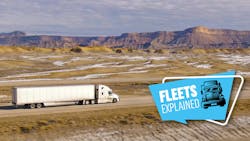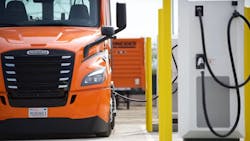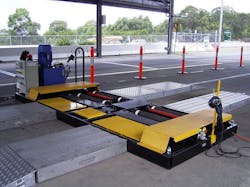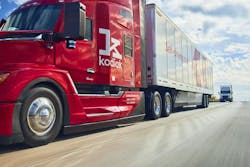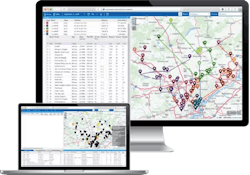Fleets Explained: What do these common trucking abbreviations mean?
The trucking industry moves quickly—physically and metaphorically. In an industry in which anything can change everything at any moment—natural and unnatural disasters, legislation, technological advancements, etc.—those in trucking have to work quickly and be highly adaptable. It’s no wonder then that this industry has a high number of abbreviations that, to a newcomer, can be baffling.
To help trucking newbies tackle this learning curve, let’s go over the most common abbreviations used in the trucking industry. Generally, trucking abbreviations can be broken down into three categories: operations, equipment, and technology.
This is part of FleetOwner's Fleets Explained, a Trucking 101 series to break down aspects of the trucking and fleet management industries. You can read more from the series, launched in May 2024, at fleetowner.com/fleets-explained. To submit topic ideas, clarifications, and corrections, email [email protected].
What are common trucking operations terms?
The following terms focus on trucking operations. By understanding these terms, you’ll better grasp how the trucking industry operates from driver to dispatcher to fleet manager.
1. What does CDL/CLP mean?
CDL stands for commercial driver’s license. In the U.S., a driver must have a CDL from their home state in order to legally operate a commercial vehicle, according to Motive. There are three different classes of CDLs:
- Class A: A Class A CDL is the most common commercial driver’s license, according to Swift Transportation. Since a Class A CDL is the highest ranking of CDLs, having one allows drivers to operate Class B and C vehicles. A Class CDL specifically permits drivers to operate flatbeds, tankers, and livestock carriers.
- Class B: A Class B CDL allows drivers to operate box trucks, straight trucks, passenger buses, dump trucks, and more.
- Class C: A Class C CDL allows drivers to operate school buses, passenger vans, and small hazmat vehicles.
CLP stands for commercial learner’s permit. Similarly to the process of obtaining a passenger driver’s license, a driver must first pass a test to obtain a CLP. A CLP allows drivers to operate a commercial vehicle for practice before obtaining a CDL. While driving with a CLP, a driver must be supervised by a qualified CDL holder, according to Schneider.
2. What does CSA mean?
CSA stands for Compliance, Safety, and Accountability. CSA is a safety compliance and enforcement program run by the Federal Motor Carrier Safety Administration that holds carriers and drivers accountable for their role in safety. According to FMCSA, a trucking company’s safety data appears online in FMCSA’s safety measurement system. FMCSA updates the SMS once a month with data from roadside inspections, including driver and vehicle violations, crash reports from the last two years, and investigation results.
3. What does CMV mean?
CMV stands for commercial motor vehicle. A CMV is any motor vehicle used on a highway in interstate commerce to transport property or passengers, according to the FMCSA. Additional requirements include:
- A gross vehicle weight rating of 10,001 lb. or more
- Single or combination of vehicles with a gross vehicle weight rating of 26,001 lb. or more
- Designed or used to transport more than eight passengers (including the driver) for compensation; or more than 15 passengers if not receiving compensation for the transportation
- Any size vehicle that transports hazardous materials that require federal placarding
4. What does DC mean?
DC stands for distribution center. A distribution center is a facility that receives inventory from manufacturing and then distributes those goods to stores, according to Penske Logistics. A distribution center is a bridge between suppliers and customers and is a key part of the distribution chain.
5. What does FTL mean?
FTL stands for full truckload. Simply put, FTL (also commonly referred to as TL) shipments take a full truck. With FTL, cargo is loaded onto a truck and taken from point A to point B, usually with no other cargo stops, according to the National Motor Freight Traffic Association. This method of shipping is typically popular for businesses moving a large amount of cargo.
6. What does LTL mean?
LTL stands for less-than-truckload. LTL shipments are like they sound—one batch of cargo from one source isn’t large enough to take up a whole trailer, so the trailer is instead filled with cargo from multiple sources. According to the NMFTA, the truck will make multiple stops to pick up and deliver cargo, or the cargo is separated at a distribution center and loaded onto smaller vehicles for delivery. LTL works best for shipments that are small and less time-sensitive.
See also: Fleets Explained: What are trucking segments?
7. What does HOS mean?
HOS stands for hours of service. Hours of service are the maximum amount of time commercial vehicle drivers can be officially on duty, according to the FMCSA. HOS mandates the number and length of breaks for drivers to ensure driver safety. New HOS regulations were released in 2020.
8. What does OEM mean?
OEM stands for original equipment manufacturer. OEMs sell both trucks and their individual parts. In trucking, the big OEMs include Freightliner, Peterbilt, Kenworth, International Trucks, Volvo, Mack, and Western Star.
9. What does O/O mean?
O/O stands for owner-operator. An owner-operator is a driver who owns their own trucking company rather than being employed by another fleet. Owner-operators either own or lease their CMVs, according to Schneider.
10. What does OOS mean?
OOS stands for out of service. A truck or driver can be temporarily or permanently out of service for a variety of reasons including equipment failure, safety violations, HOS violations, and drug/alcohol abuse, according to Motive. The FMCSA has the power to place a truck or driver OOS.
11. What does OTIF mean?
OTIF stands for on-time in-full. This is a supply chain metric that measures a supplier’s ability to deliver products within the prescribed delivery windows and at the full quantities ordered, according to Four Kites. OTIF is used to judge the performance of the supply chain, especially when it comes to inventory planning, inventory optimization, and order fulfillment.
12. What does OTR mean?
OTR stands for over-the-road trucking. OTR is also referred to as long-haul trucking, according to Truckstop. OTR can be defined as covering distances of 250 to 1,000 miles or more. This means drivers take longer trips than in local or regional hauling, sometimes spending weeks away from home.
13. What does P&D mean?
P&D stands for pick-up and delivery. P&D drivers operate in route sales or pick-up-and-delivery operations, according to the California Trucking Association. These drivers have more contact with customers than OTR drivers and usually make more stops per day.
What are common trucking equipment terms?
The following terms focus on trucking equipment. These terms have to do with types of trucks, trucking equipment, maintenance, and more.
1. What does ABS mean?
ABS stands for anti-lock braking systems. ABS helps drivers maintain steering control in an emergency braking situation, according to the Commercial Vehicle Safety Alliance. When the brakes are applied, the ABS senses if a wheel is about to lock and then releases enough brake force to keep the wheel rolling while still maintaining as much braking force on the wheel as possible.
2. What does APU mean?
APU stands for auxiliary power unit. An APU is a device that produces power for a truck without idling the truck, according to International Used Truck Centers. Especially for long-haul purposes, an APU can heat or cool a truck as well as power electronics on board without wasting power through idling. APUs include both diesel and electric options.
3. What does BEV mean?
BEV stands for battery-electric vehicle. BEVs are powered by rechargeable electric batteries only, according to EVgo. BEVs do not produce emissions, unlike gasoline or diesel-powered vehicles. In trucking, BEVs are a bit of a controversial subject, as government regulations push for widespread adoption on a schedule some in the industry say is unrealistic.
See also: Fleets Explained: How are electric vehicles different?
4. What does DEF mean?
DEF stands for diesel exhaust fluid. DEF turns nitrous oxide into water and nitrogen in a vehicle’s diesel exhaust, according to International Used Truck Centers. DEF performs a chemical process in selective catalytic reduction systems installed as an emissions control device. The Environmental Protection Agency has required DEF for U.S. diesel engines since 2010.
5. What does GAWR mean?
GAWR stands for gross axle weight rating. GAWR is the maximum weight a single axle of a vehicle can support, according to Inbound Logistics. GAWR is determined by analyzing how strong an axle is and the components that go with it, like tires, brakes, and suspension.
6. What does GVWR mean?
GVWR stands for gross vehicle weight rating. GVWR is a standardized measurement specified by a vehicle manufacturer, according to Inbound Logistics. It indicates the maximum weight a vehicle can carry safely by combining its weight and cargo.
7. What does ICE mean?
ICE stands for internal combustion engine. In ICE vehicles, the ignition and combustion of the fuel occurs within the engine itself, according to the U.S. Department of Energy. The two kinds of ICEs are the spark ignition engine and the compression ignition engine. There are ICE options for electric, diesel, gas, and alternative fuel vehicles.
8. What does PBBT mean?
PBBT stands for performance-based brake tester. A PBBT is a machine used to test the performance of a vehicle’s brakes, according to the CVSA. PBBTs measure the slow-speed brake force and weight at each wheel of a vehicle, add up the total vehicle brake force, and divide it by the total vehicle weight to determine overall vehicle braking efficiency.
9. What does PM mean?
PM stands for preventive maintenance. PM involves having a vehicle inspected and maintained to avoid an accident and emergency repairs, according to J.J. Keller & Associates. Fleets perform PM on each vehicle component at its appropriate interval, which is influenced by time, fuel usage, mileage, engine hours, and environment.
10. What does RNG mean?
RNG stands for renewable natural gas. RNG is made primarily from organic waste, with sources including wastewater treatment plants, food and green waste, landfills, dairies, farms, and forest management, according to the California Renewable Transportation Alliance. Vehicles using RNG over diesel can significantly reduce greenhouse gas emissions and meet CARB standards.
What are common trucking technology terms?
This section’s terms focus on trucking technology that helps with safety, efficiency, operations, and more
1. What does ADAS mean?
ADAS stands for advanced driver assistance systems. ADAS is driver assistance technology focused primarily on safety, according to Lytx. Some potential features of ADAS are blind spot alerts and lane departure warnings. These systems can also help train drivers on potential safety risks and how to avoid them.
2. What does AV mean?
AV stands for autonomous vehicle. An AV is a vehicle equipped with sensing and computing systems that do not rely on a human to take over, according to the Autonomous Vehicle Industry Association. The concept of AVs is still relatively novel to the trucking industry but could help improve safety without the possibility of driver errors.
See also: The current state of autonomous trucking
3. What does BOL mean?
BOL stands for bill of lading. A BOL is an important document that outlines shipment details, including the type, quantity, and destination of the transported goods, according to Inbound Logistics. Traditionally, BOLs were physical documents, but now many companies use electronic versions known as eBOLs.
4. What does ELD mean?
ELD stands for electronic logging device. ELDs are used in trucking to automatically record a driver’s drive time, HOS, miles driven, vehicle engine data, and more, according to Geotab. ELDs improve communication between drivers and dispatchers.
5. What does TMS mean?
TMS stands for transportation management system. TMS uses data to make fleet operations more efficient by automating or improving certain processes, according to Truckstop. TMS can dispatch drivers, track shipments, view reports, book loads, and more.
See also: Fleets Explained: What is a TMS?
6. What does WIM mean?
WIM stands for weigh-in-motion. WIM systems measure the weight of trucks while the trucks are still moving to identify if any vehicles are overweight, according to the Washington State Department of Transportation. WIM systems do so through sensors embedded in the pavement. Through this process, vehicles aren’t forced to stop at weigh stations unless they are overweight.
What abbreviations should we cover next? Comment below to let us know!
About the Author

Jenna Hume
Digital Editor
Digital Content Specialist Jenna Hume joined FleetOwner in November 2023 and previously worked as a writer in the gaming industry. She has a Bachelor of Fine Arts degree in creative writing from Truman State University and a master of Fine Arts degree in writing from Lindenwood University. She is currently based in Missouri.
